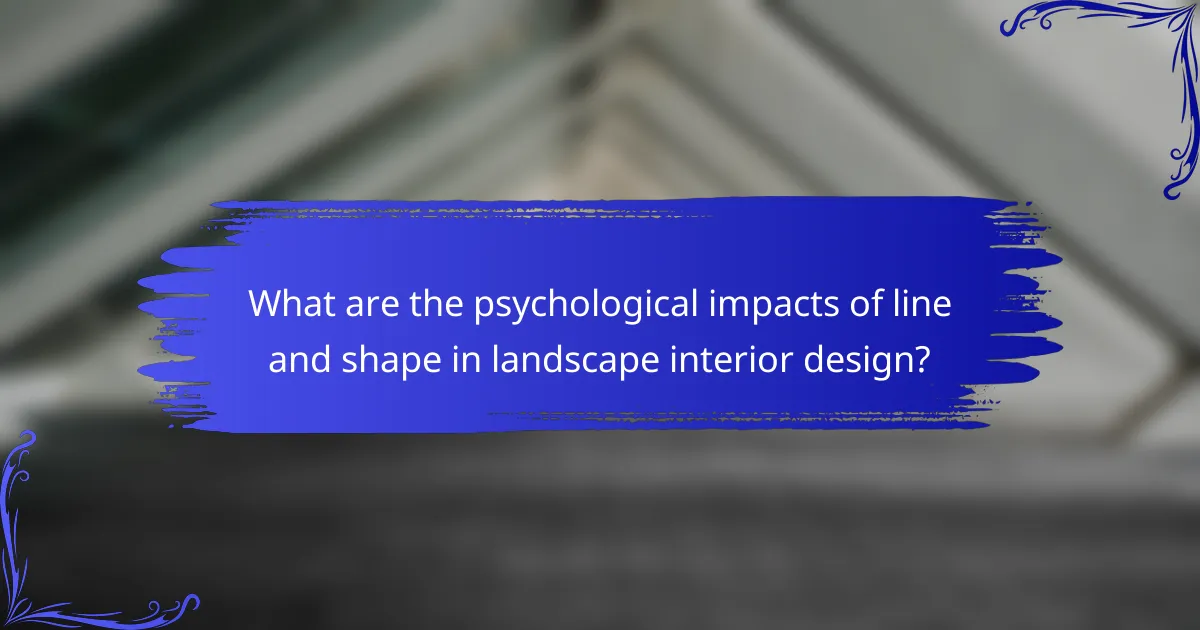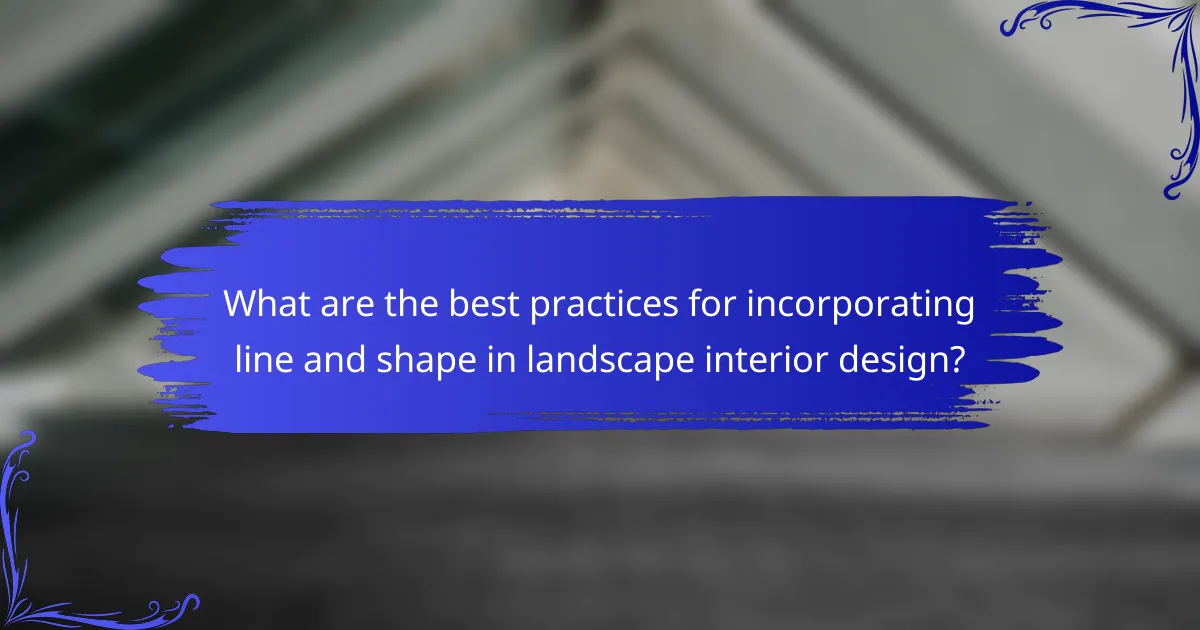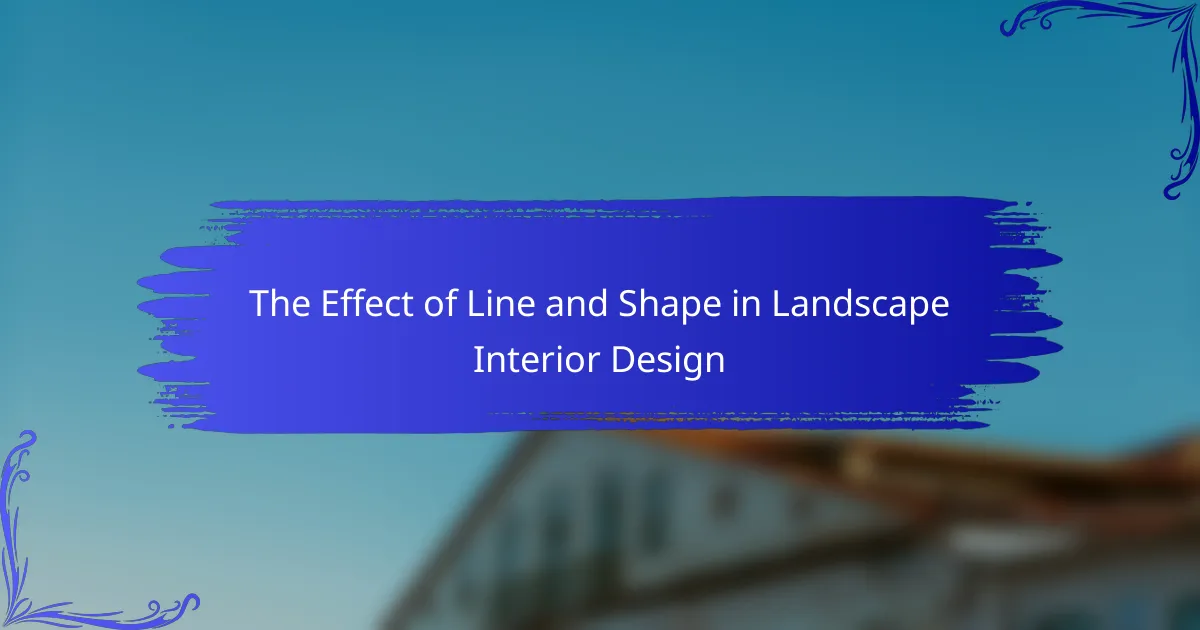The article examines the impact of line and shape on aesthetic and spatial dynamics in landscape interior design. It highlights how lines, including straight, curved, horizontal, and vertical, guide movement and convey different emotional responses, while shapes such as circles, squares, and triangles create harmony or contrast within a space. Research findings indicate that these design elements can significantly influence psychological responses, mood, and behavior, enhancing user experience. Best practices for incorporating line and shape into landscape design are outlined, emphasizing the importance of balance, layering, and the integration of color and texture to foster visual interest and harmony.

What is the Effect of Line and Shape in Landscape Interior Design?
Line and shape significantly influence the aesthetic and spatial dynamics in landscape interior design. Lines guide the eye and create pathways, while shapes define areas and structures. Horizontal lines promote tranquility, while vertical lines convey strength. Curved lines introduce fluidity and movement. Shapes, such as circles, squares, and triangles, establish harmony or contrast. For example, circular shapes can soften a space, while angular shapes may create a more structured feel. The arrangement of these elements can affect perceptions of space. Research shows that well-designed lines and shapes enhance user experience and emotional response in a landscape setting.
How do line and shape influence the overall aesthetics of a landscape interior?
Line and shape significantly influence the overall aesthetics of a landscape interior. Lines can guide the viewer’s eye and create movement within the space. Straight lines often evoke a sense of order and structure. Curved lines can introduce softness and fluidity. Shapes contribute to the overall composition and balance of the design. Geometric shapes tend to create a modern and organized feel. Organic shapes can enhance a natural and relaxed atmosphere. The interaction between line and shape can establish focal points and zones within the landscape. This dynamic can lead to a cohesive and visually appealing environment.
What are the different types of lines used in landscape interior design?
The different types of lines used in landscape interior design include straight lines, curved lines, diagonal lines, and zigzag lines. Straight lines create structure and organization. They guide the eye and establish a sense of order. Curved lines add softness and flow to a design. They can create a more organic and natural feel. Diagonal lines introduce dynamism and movement. They can make a space feel more energetic. Zigzag lines can create visual interest and excitement. Each line type contributes to the overall aesthetic and functionality of the landscape design.
How do geometric shapes contribute to the design’s visual appeal?
Geometric shapes enhance a design’s visual appeal by creating balance and harmony. They provide structure and organization, guiding the viewer’s eye. Shapes like circles, squares, and triangles evoke specific emotions and associations. For instance, circles suggest unity, while squares imply stability. According to design principles, these shapes can influence perception and engagement. Studies show that designs incorporating geometric shapes are often perceived as more aesthetically pleasing. This is due to their ability to create rhythm and movement within a space. Overall, geometric shapes play a crucial role in effective visual communication in design.
Why are line and shape important in creating functional spaces?
Line and shape are crucial in creating functional spaces as they influence flow and organization. Lines guide movement and direct attention within a space. They can create boundaries, define areas, and enhance visual interest. Shapes contribute to the overall aesthetic and functionality of a design. For example, geometric shapes can create a sense of order, while organic shapes can evoke a feeling of relaxation. Research shows that well-defined lines and shapes can improve spatial perception and usability (K. H. Kim, “The Role of Line and Shape in Spatial Design,” Journal of Interior Design, 2020). This evidence supports the significance of line and shape in achieving effective design outcomes.
How do they affect spatial organization in landscape interiors?
Lines and shapes significantly influence spatial organization in landscape interiors. They create pathways and define areas within a space. Straight lines can lead the eye and promote a sense of order. Curved lines often introduce a feeling of flow and movement. Shapes can establish focal points and balance within the design. For instance, geometric shapes can create structured environments. Organic shapes can enhance natural aesthetics and harmony. The arrangement of these elements affects how users interact with the space. Effective use of lines and shapes can optimize functionality and aesthetic appeal in landscape interiors.
What role do line and shape play in guiding movement within a space?
Lines and shapes play a crucial role in guiding movement within a space. They create pathways and direct the flow of movement. Lines can be straight, curved, or angular, influencing how a person navigates through an area. For example, straight lines often suggest direct paths, while curves can create a sense of exploration. Shapes define areas and can indicate function, such as seating or walking zones. The arrangement of these elements can either open up spaces or create barriers. Research shows that well-designed lines and shapes enhance user experience by promoting intuitive navigation. Studies highlight that environments with clear visual cues reduce confusion and improve accessibility.

What are the psychological impacts of line and shape in landscape interior design?
Line and shape in landscape interior design significantly influence psychological responses. Straight lines often evoke feelings of order and stability. Curved lines can promote relaxation and a sense of flow. Shapes like circles may symbolize unity and completeness. Conversely, sharp angles can create tension or unease.
Research indicates that design elements affect mood and behavior. For instance, a study published in “Environment and Behavior” found that curved pathways in gardens reduce stress levels. Additionally, the presence of geometric shapes can enhance cognitive function by providing visual clarity.
Thus, the psychological impacts of line and shape are crucial in shaping user experiences in landscape interior design.
How can line and shape evoke emotions in a landscape interior?
Line and shape can evoke emotions in a landscape interior by influencing perception and mood. Curved lines often create a sense of calm and relaxation. They mimic natural forms found in nature, promoting tranquility. In contrast, sharp lines can evoke tension or excitement. They create a dynamic energy in the space.
Shapes also play a crucial role in emotional response. Organic shapes are associated with comfort and warmth. Geometric shapes can impart a sense of order and stability. The arrangement of lines and shapes can guide the viewer’s eye, affecting their experience of the space.
Research indicates that specific line and shape combinations can trigger emotional reactions. For example, a study published in the Journal of Environmental Psychology found that rounded shapes can enhance feelings of safety. Overall, the thoughtful use of line and shape is essential in landscape interior design to evoke desired emotional responses.
What specific emotions are associated with different types of lines?
Curved lines evoke feelings of softness and tranquility. They create a sense of flow and movement in a space. Sharp, angular lines often convey energy and tension. These lines can create a dynamic and dramatic atmosphere. Horizontal lines promote calmness and stability. They provide a sense of balance and restfulness. Vertical lines are associated with strength and height. They can evoke feelings of aspiration and growth. Diagonal lines suggest action and excitement. They can create a sense of urgency or movement in a design.
How do shapes influence the mood of a space?
Shapes significantly influence the mood of a space. Geometric shapes create a sense of order and stability. For example, squares and rectangles evoke feelings of security. Organic shapes, like curves, promote relaxation and comfort. Sharp angles can induce tension and energy. The use of shapes affects how individuals perceive and interact with their environment. Research shows that spaces designed with harmonious shapes can enhance well-being. A study published in the Journal of Environmental Psychology found that rounded shapes lead to more positive emotional responses compared to angular shapes. Therefore, the choice of shapes is crucial in landscape interior design.
Why is it essential to consider user perception in landscape interior design?
User perception is essential in landscape interior design because it directly influences how individuals experience a space. Understanding user perception helps designers create environments that evoke desired emotional responses. For instance, specific lines and shapes can enhance feelings of tranquility or energy. Research indicates that well-designed landscapes can improve mental well-being and reduce stress levels. A study published in the Journal of Environmental Psychology found that people prefer spaces that align with their personal preferences and perceptions. This preference significantly impacts their satisfaction and usage of the space. Therefore, considering user perception is crucial for effective landscape interior design.
How do line and shape affect user experience in a landscape interior?
Line and shape significantly influence user experience in a landscape interior. Lines guide movement and create pathways, impacting how individuals navigate the space. Straight lines often evoke a sense of order and control. Curved lines can introduce a feeling of relaxation and flow. Shapes contribute to the overall aesthetic and can affect emotional responses. Geometric shapes may convey modernity, while organic shapes can create a natural, calming environment. Research indicates that well-designed lines and shapes can enhance user comfort and satisfaction. For instance, a study by Kaplan and Kaplan (1989) highlights how spatial organization affects perception and behavior in environments.
What strategies can designers use to enhance user perception through line and shape?
Designers can enhance user perception through line and shape by employing strategies such as creating visual hierarchy, guiding the eye, and evoking emotions. Visual hierarchy can be established by varying line thickness and shape size. Thicker lines often draw more attention, while thinner lines can create subtlety. Guiding the eye involves using lines to lead viewers through a space, creating a sense of flow. For instance, curved lines can suggest movement, while straight lines can create order. Additionally, shapes can evoke emotions; circular shapes often convey harmony and comfort, while angular shapes may suggest energy or tension. Research indicates that users respond differently to various shapes, with studies showing that rounded shapes are generally perceived as more friendly (Löw et al., 2016). By strategically using line and shape, designers can significantly impact user experience and perception.

What are the best practices for incorporating line and shape in landscape interior design?
Best practices for incorporating line and shape in landscape interior design include using lines to guide movement and create pathways. Straight lines can evoke a sense of order, while curved lines can offer a more relaxed feel. Shapes should complement the overall design theme, whether geometric or organic. Balance between different shapes enhances visual interest. Layering shapes adds depth and dimension to the space. Utilizing focal points, such as sculptures or trees, draws attention and creates structure. Color and texture can further define lines and shapes, enhancing their impact. Overall, a cohesive integration of these elements fosters harmony in landscape design.
How can designers effectively utilize line and shape to create harmony?
Designers can effectively utilize line and shape to create harmony by ensuring that these elements are consistent and complementary throughout their work. Lines can guide the eye and create movement, while shapes can establish balance and structure. Using geometric shapes can evoke a sense of order, while organic shapes can introduce a natural flow. Designers should consider the relationship between lines and shapes to reinforce the overall theme of a space. For example, a series of curved lines can soften a room, while straight lines can create a more formal feel. Consistency in line thickness and shape proportions can enhance visual cohesion. Research indicates that harmonious designs promote a sense of well-being and comfort. In landscape interior design, effective line and shape usage can significantly impact the viewer’s experience and emotional response.
What techniques can be used to balance lines and shapes in a design?
Techniques to balance lines and shapes in design include symmetry, asymmetry, and radial balance. Symmetry involves mirroring elements on either side of a central axis. This creates a sense of harmony and stability. Asymmetry, on the other hand, balances elements of different sizes and visual weights. It can create dynamic and interesting compositions. Radial balance arranges elements around a central point, leading the eye outward in a circular motion. Additionally, the use of color and contrast can enhance the perception of balance. For example, contrasting colors can draw attention to specific shapes, helping to balance the overall design. These techniques are foundational in achieving visual equilibrium in landscape interior design.
How can contrast between line and shape enhance a design?
Contrast between line and shape enhances a design by creating visual interest and depth. Lines can guide the viewer’s eye, while shapes provide structure and form. This interplay can emphasize specific areas within a design. For instance, sharp lines can contrast with soft, rounded shapes, making elements stand out. Research in design psychology shows that contrasting elements can evoke emotional responses. A study by the Design Research Society found that contrast increases viewer engagement. Therefore, effective use of line and shape can elevate the overall aesthetic and functionality of a space.
What common mistakes should be avoided when using line and shape?
Common mistakes to avoid when using line and shape include overusing complex shapes. This can create visual confusion and detract from the design’s overall harmony. Another mistake is neglecting the balance between lines and shapes. An imbalance can lead to a disjointed look. Failing to consider the scale of lines and shapes is also problematic. Lines that are too thin may get lost, while overly thick lines can overwhelm a space. Additionally, not aligning lines and shapes with the intended flow of the design can disrupt the viewer’s experience. Lastly, ignoring the context of the environment can result in designs that feel out of place. These principles are essential for creating cohesive and effective landscape interior designs.
How can improper use of line and shape detract from a landscape interior?
Improper use of line and shape can significantly detract from a landscape interior by creating visual dissonance. Lines that are misaligned or shapes that clash can disrupt the intended flow of a space. This may lead to a lack of harmony and balance, making the environment feel chaotic. For example, harsh, jagged lines can evoke tension, while soft, flowing lines promote tranquility. A study by the American Society of Landscape Architects indicates that well-defined lines enhance spatial organization. In contrast, poorly executed shapes can confuse spatial perception, making areas appear smaller or more congested. Ultimately, the effectiveness of a landscape interior relies on the thoughtful application of line and shape to maintain aesthetic appeal and functionality.
What are the signs of ineffective line and shape implementation?
Ineffective line and shape implementation is indicated by several signs. Disjointed or chaotic designs often signal poor use of lines and shapes. Inconsistent flow within a space can disrupt harmony. Lines that do not guide the eye can create confusion. Shapes that clash rather than complement lead to visual discord. Lack of balance in the arrangement of elements is another clear sign. Unclear focal points can detract from the overall design intent. Lastly, failure to create a sense of unity among various elements indicates ineffective implementation.
What tips can help designers master the use of line and shape?
Designers can master the use of line and shape by practicing basic principles of geometry. Understanding geometric shapes helps in creating balanced compositions. Experimenting with different line weights can add depth to designs. Using horizontal lines conveys stability, while vertical lines suggest height. Curved lines can create movement and flow in a space. Incorporating shapes in a modular fashion allows for versatility in design. Observing nature provides inspiration for organic shapes and lines. Analyzing successful designs helps in understanding effective line and shape usage.
The main entity of the article is the effect of line and shape in landscape interior design. The article explores how lines and shapes influence aesthetics, spatial organization, and user experience in interior landscapes. It discusses various types of lines, such as straight, curved, and diagonal, and their psychological impacts, including how they evoke emotions and guide movement. Additionally, the article highlights the importance of geometric and organic shapes in creating harmony and balance within a space, while also covering best practices and common mistakes in their application.
